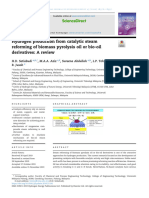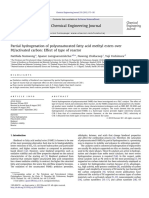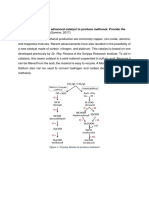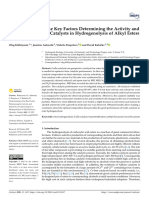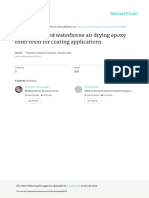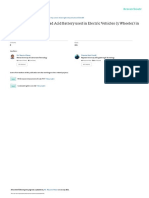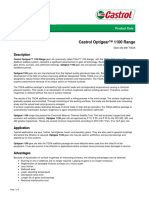Art20164464 PDF
Art20164464 PDF
Uploaded by
muksadur rahmanCopyright:
Available Formats
Art20164464 PDF
Art20164464 PDF
Uploaded by
muksadur rahmanOriginal Description:
Original Title
Copyright
Available Formats
Share this document
Did you find this document useful?
Is this content inappropriate?
Copyright:
Available Formats
Art20164464 PDF
Art20164464 PDF
Uploaded by
muksadur rahmanCopyright:
Available Formats
See discussions, stats, and author profiles for this publication at: https://www.researchgate.
net/publication/320033802
Improving Formation Efficiency of Lead Acid Battery using Hydrogen Peroxide
as an Additive
Article in International Journal of Science and Research (IJSR) · January 2017
CITATIONS READS
0 1,714
3 authors, including:
P. Senthil Kumar Sumanth Vinay kumar Balla
Amara Raja Batteries Limited TDSG
6 PUBLICATIONS 5 CITATIONS 3 PUBLICATIONS 1 CITATION
SEE PROFILE SEE PROFILE
Some of the authors of this publication are also working on these related projects:
Lead acid formation View project
Improving Formation Efficiency of Lead Acid Battery using Hydrogen Peroxide as an Additive View project
All content following this page was uploaded by Sumanth Vinay kumar Balla on 26 September 2017.
The user has requested enhancement of the downloaded file.
International Journal of Science and Research (IJSR)
ISSN (Online): 2319-7064
Index Copernicus Value (2015): 78.96 | Impact Factor (2015): 6.391
Improving Formation Efficiency of Lead Acid
Battery using Hydrogen Peroxide as an Additive
Senthil Kumar P1, Bhanu Prasad R2, Sumanth Vinay Kumar B3, Babu N4, Balaji G5, Jagadish M6
Research and Engineering Centre, Amara Raja Batteries Limited, Tirupathi, Andhra Pradesh, India - 517520
Abstract: Formation is one of the critical step in lead acid battery manufacturing process. The purpose of formation process is to
convert the cured paste into electrochemically active porous paste i.e. lead dioxide as positive plate and sponge lead as negative plate
respectively. In the present work we studied “ Improving formation efficiency of lead acid battery using hydrogen peroxide as an
additive”. This additive is oxidizing in nature. When this additive is subjected to high temperature or dissolved in water, it releases
nascent oxygen. The nascent oxygen reacts with semi-conductive lead monoxide and converts it as conductive lead dioxide. The
presence of lead dioxide in cured paste thus increases conductivity of plate and reduces the formation energy required for conversion
during formation. So, to establish the impact of this additive on lead dioxide conversion and formation energy, samples made with and
without addition of hydrogen peroxide. From XRD analysis, conversion of formed paste and formed cell discharge capacity test, it was
observed that this additive can reduce the formation energy potentially up to 20%.
Keywords: lead acid batteries, paste additive, oxidizing additive, formation efficiency, formation energy
1. Introduction material. Since this form of silica is porous, the additive may
act as an acid reservoir [4].
The process of formation can be conducted based on two
basic methods namely, tank formation and container Acid recirculation formation process is the one of the
formation. In the earlier case, cured positive and negative solution for the formation of Flooded Automotive and
plates are formed in large electrolytic tanks containing Industrial batteries. The process permits to maintain the
H2SO4 of 1.08-1.10 relative density and then plates are constant temperature all over the plates inside the batteries,
assembled. Whereas in case of container formation, cured highly reducing the cycle time and increasing the quality of
positive and negative plates are assembled into groups along the formation process [5].
with separator, which are then placed into the battery
container and subjected to formation after filling with H2SO4 Different conductive additives for positive plates to improve
[1-2]. In both the methods of formation processes the formation efficiency includes Barium plumbate,
conversion of positive plates consumes more time and Titanium oxide, Tin dioxide, Lead dioxide, Carbon and
energy than negative plates. Oxidation of bivalent lead Conductive Polymers were studied [1]. D Pavlov studied the
compounds in the paste and formation of the lead dioxide effect of read lead as a conductive additive to improve the
positive active mass passes through a number of chemical formation efficiency [2]. K.R Bullock et al investigated the
reactions, some of which proceed at a low rate, which ozone treatment that enhances conductivity of positive
retards the technological process of formation of the positive material [6].
plate. In an attempt to accelerate the formation process,
various studies had been carried out to improve the rate of The patent - US 2,658,097 A, manufacture of positive plates
conversion of lead dioxide and to reduce the formation for lead storage batteries issued Nov. 3, 1953 mentioned that
energy. Earlier studies include two shot formation in The oxidizing solution may be applied to the positive plates
container formation process, acid recirculation formation by immersing the plates in the solution or by applying the
process, pulse charging and paste additives which includes solution by dipping, painting, spraying or other known
conductive, porous and electrolyte additives. method. We have found it convenient to immerse the plates
in the solution for an interval of time sufficient to form a
Generally two formation methods are applied in container thin deposit of higher oxides of lead on the surface of the
formation, two shot and single shot formation. In the two active material in the positive plates. [7].
shot formation, the battery is filled with H2SO4 of relative
density 1.08-1.15, after completion of formation the The patent - US 4909955 A, Lead oxide paste mix for
electrolyte is replaced with higher relative density H 2SO4 to battery grids and method of preparation issued on 20 Mar
achieve the required relative density this is the one of the 1990 mentioned that, battery grades of oxides of lead are
efficient process to reduce the formation energy and mixed with a dilute solution of hydrogen peroxide, either
formation cycle time [1-3] alone or with additives and/or expanders. The resultant paste
offers such advantages as reduced curing and drying times
The 0.2 wt% (Silica gel) of material addition resulted in and/or the elimination of the need for curing and drying,
improved capacity at both low and high rates. Althoughthe lower dry active material weights and improved cohesion
addition of silica gel was not observed to cause significant when compared to conventional pastes manufactured from
physiochemical changes to the positive active-material; it is leady oxides, sulfuric acid, and water [10].
possible that silica gel promotes nucleation which
consequently leads to a finer pore structure in the active
Volume 6 Issue 1, January 2017
www.ijsr.net
Licensed Under Creative Commons Attribution CC BY
Paper ID: ART20164464 1631
International Journal of Science and Research (IJSR)
ISSN (Online): 2319-7064
Index Copernicus Value (2015): 78.96 | Impact Factor (2015): 6.391
The patent - US 5149606 A, method of treating battery 2.2 Mechanism of HP
electrode with per-sulfate issued on 22 September 1992,
discloses that, Improved formation efficiencies for positive HP is a strong oxidizing agent with high percentage of
pasted plates used in lead-acid batteries are provided by active oxygen. But when it is dissolved in water or exposed
treatment of the positive plates with a stabilized aqueous to elevated temperatures, nascent oxygen gets evolved. This
alkaline persulfate solution to effect the conversion of lead nascent oxygen has the potential to react with leady oxide in
monoxide to lead dioxide. Use of the alkaline persulfate such a manner that both residual lead and lead monoxide in
solution enhances both formation and initial performance of the leady oxide will get oxidized.The following reactions are
the fabricated batteries [8]. expected to occur and to establish the below reactions
experiment detailed in section 2.3.1 has been carried out
Pulse charging option is available for the formation, it is [12].
used together with constant voltage/current profiles to
increase charge acceptance, improve the charging time and HP:
to potentially increase the life cycle of lead acids cells [9].
In the present study we focused mainly on oxidizing additive
to reduce the formation energy, by mixing the additive with
paste. The effect was studied after curing, drying and
formation. The concept of using additive to improve 2.3 Experimental procedure
formation efficiency has been explored as it is easy to adopt
in manufacturing and economical. 2.3.1 Leady oxide mixing with HP
To verify the above mechanism 5 g of laboratory reagent
2. Experimental grade HP (50% H2O and 50% H2O2) is slowly (drop by
drop) mixed with 50 g of Barton mill leady oxide in the
4.5” × 2.5” × 0.5” (H × W × T) Ca-Sn alloy based gravity laboratory with continuous stirring at room temperature for
casted grid was chosen for experimentation. Experiments 15 minutes, followed by 20 hrs drying at 60°C and analysis
were conducted with different percentages of additive as was carried out to confirm the above mechanism. The results
shown in the Table 2 with respect to the weight of leady are discussed in 3.1.
oxide. Hydrogen peroxide is chosen as an additive for
experimentation, it was added during paste mixing in 2.3.2 HP as an additive in paste
positive active material considering the available active To study the effect of HP as an additive in paste mixing,
oxygen in it. Here onwards hydrogen peroxide and active curing and drying and formation, positive plates were
oxygen are denoted as HP and AO respectively. prepared in the laboratory by mixing with different
percentages of HP (50% H2O and 50% H2O2) as stated in the
2.1 Material properties Table 2 in paste mixing. Samples were made by the below
procedure. The results are discussed in 3.2 and 3.3.
HP is a colorless free flowing liquid, slightly viscous than
water. It is an oxidizing agent with solid source of AO. It is Table 2: Hydrogen peroxide addition with respect to leady
readily soluble in water and can easily decompose at oxide
elevated temperatures thus releases nascent oxygen. Physical Sample (50%HP) Leady oxide (g)
and chemical properties of HP are described in the Table 1 No additive (NA) 1000
[10]. 1.07 g (0.3 g AO) 1000
2.14 g (0.6 g AO) 1000
2.1.1 Physical and chemical properties 5 g (1.17 g AO) 50
Table 1: Physical and chemical properties
50% H2O2 2.3.3 Preparation of positive paste and plate
S. No Property UOM
(50 % H2O + 50% H2O2) Positive paste was prepared by using Barton mill leady
1 Molecular weight g/mole 34.01 oxide (with 22-28 wt. % residual lead). Binder (poly
2 Appearance - Free flowing liquid ethylene terephthalate) was mixed with leady oxide and HP
3 Water solubility @250 C g/l Miscible solution was introduced slowly into the leady oxide with
4 Density g / ml 1.20 different percentages as specified in Table 2 with good
5 Active oxygen % 23.54 dispersion over the paste and mixing is carried out for 3
6 pH - <3 minutes. After mixing, water added as quickly as possible
and uniformly mixed (wet mixing) for 3 minutes. After
2.1.2 Chemical Structure completion of wet mix, sulfuric acid (1.40 relative density)
Chemical name Chemical structure (ball and stick model) of battery grade was added to the mix in such a way that
maintaining mix temperature below 60°C to form a specific
Hydrogen paste morphology i.e., tri basic lead sulfates. Final mix was
peroxide done for 3 minutes followed by the measurement of paste
density.
Paste densities were adjusted to 4.20 g cm-3.Required
quantity of paste weighed in a micro balance and manually
Volume 6 Issue 1, January 2017
www.ijsr.net
Licensed Under Creative Commons Attribution CC BY
Paper ID: ART20164464 1632
International Journal of Science and Research (IJSR)
ISSN (Online): 2319-7064
Index Copernicus Value (2015): 78.96 | Impact Factor (2015): 6.391
pasted on grid panelwhich is mentioned above. After standard aluminum glass-slide-back sample holder.
pasting, panel was weighed and loaded into curing and RIGAKU ULTIMA-IV X-Ray diffractometer was used with
drying oven. Plates were cured at 50°C by maintaining 95% Cu Kα radiation. Scans were conducted in the 2θ range of
relative humidity for 48 hours and dried at 60°C for 24 hours 10–90°, with a scan time of 4deg.min-1. Different phase
and plates were assembled in a commercial AGM battery compositions (3BS, PbO, Pb and PbO2) were analyzed and
case to form a dry unformed battery. they are explained in 3.1.2 and 3.2.1.
2.4.3 Paste morphology
2.3.4 Cell formation The analysis of paste morphology of positive cured paste
Required amount of chilled sulphuric acid (<150C) with without and with HP was determined by scanning electron
1.290 relative density was filled into the dry unformed microscopy (SEM). All samples were sputter coated with a
battery using vacuum filling. After soaking the plates in thin layer of platinum, ~5 nm in thickness, to reduce
electrolyte for 1 hr, charging was conducted. Connecting charging and improve image quality. Examination was
cables were connected to the battery in series and then carried out in a JEOL JSM-6010PLUS low vacuum model
allowed for charging using constant current charging process SEM using a working distance of 12 mm, a spot size of 30,
with water circulation to control the temperature during and an electron beam voltage of 10 kV.
formation. The Ah input during formation has been varied
between 5 to 6 times of its designed rated capacity of the 2.4.4 Formed cell discharge capacity test
cell in order to evaluate the effect of additive on reduction in Initial capacity tests were performed on formed cell in which
input formation energy and improve in conversion positive formed paste made with, without and with HP.
efficiency. Tests carried out at 10 h rate current by BITRODE LCN
CIRCUIT, USA. The initial capacity test results are given in
2.4 Analysis Table 5.
Leady oxide without and with HP as explained in 2.3.1, was 3. Results and Discussion
analyzed by dissolution and precipitation method and XRD.
3.1 Leady oxide mixing with HP
Positive cured paste without and with HP (1.07 g and 2.14 g)
was analyzed by XRD and SEM. Positive formed paste 3.1.1 Residual lead after mixing
without and with HP was analyzed for lead dioxide content Residual lead percentage in leady oxide before and after
by dissolution and precipitation method and for initial mixing with HP (50% HP) was shown in Table 3. From the
capacity at 10 h rate. results reduction of 3.4% (average) of residual lead was
observed after mixing with HP followed by drying. This
2.4.1 Analysis of residual lead and lead dioxide content indicates that, when leady oxide is mixed with HP, the
residual lead gets partially oxidized to lead monoxide this
2.4.1.1 Residual lead content in leady oxide after mixing results in residual lead reduction. This is in line with the
with HP earlier investigation of X.L. Wang et al [12]. Since, the
5 g of leady oxide without and with HP was dissolved in 5% effect of HP on oxidation of residual lead was already
acetic acid solution. Lead monoxide can effectively dissolve investigated (by X.L Wang et al), further experimentation
in acetic acid solution and the residual lead gets precipitated was not detailed here.
at the bottom; it is filtered, dried and weighed.
Table 3: Oxidation of residual lead after treating with 50%
2.4.1.2 Analysis of lead dioxide content in formed paste HP
The positive formed paste contains lead dioxide, lead sulfate Residual lead (wt. %)
and lead monoxide. Lead dioxide content in formed paste Sample Leady oxide (g)
Before mixing After mixing
was determined by the following methodology. 26.6 22.8
25.3 21.3
5 g of positive formed paste was dissolved in 20% 5 g of 50% HP 50
27.2 24.2
ammonium acetate solution. Lead sulfate and lead monoxide 19.4 16.5
can effectively dissolved in this solution and lead dioxide
gets precipitated at the bottom; it is filtered, dried and 3.1.2 Lead dioxide after mixing
weighed. XRD analysis was carried out on leady oxide without and
with HP for lead dioxide peaks. Results were shown in Fig.
2.4.2 XRD analysis (X-Ray Diffractometer) 1 and Fig. 2. From the results, the additional lead dioxide
The analysis of phase composition of the leady oxide and peaks were observed when leady oxide mixed with HP and
positive cured paste without and with HP was determined by here λ, ɸ and Ɵ are the lead monoxide, residual lead and
using X-raydiffractometry. Samples collected after curing lead dioxide respectively.
and drying was grinded into a fine powder and placed into a
Volume 6 Issue 1, January 2017
www.ijsr.net
Licensed Under Creative Commons Attribution CC BY
Paper ID: ART20164464 1633
International Journal of Science and Research (IJSR)
ISSN (Online): 2319-7064
Index Copernicus Value (2015): 78.96 | Impact Factor (2015): 6.391
Figure 1: Leady oxide without HP addition
Figure 2: Leady oxide with HP addition
From the above XRD results, when leady oxide is mixed drying and for lead dioxide peaks. Results were shown in
with HP, there is a slight reduction in residual lead Fig. 3, 4 and 5. The characteristic lines of the substances are:
percentage and at the same time lead dioxide phases were tri basic lead sulfate, lead monoxide and lead dioxide. They
observed at 2Ɵ of 34.18, 59.28 and 77.82 degrees. So, the are denoted by γ, λ and ϴ respectively. So, in positive cured
mechanism explained in 2.2 is expected to occur in this paste with HP, lead dioxide peaks were observed at 2Ɵ of
particular additive. 30.28, 45.63, 56.95, 59.92 and 77.86 degrees, after paste
mixing, curing and drying process i.e., lead monoxide
3.2 HP as an additive in paste converts into lead dioxide due to availability of AO in the
additive, as explained in chapter 2.2 Mechanism of HP.
3.2.1 XRD analysis
XRD analysis of positive cured paste without and with HP
was carried out to check the reaction of HP in curing and
Figure 3: Without HP addition
Volume 6 Issue 1, January 2017
www.ijsr.net
Licensed Under Creative Commons Attribution CC BY
Paper ID: ART20164464 1634
International Journal of Science and Research (IJSR)
ISSN (Online): 2319-7064
Index Copernicus Value (2015): 78.96 | Impact Factor (2015): 6.391
Figure 4: 1.07 g HP addition
Figure 5: 2.14 g HP addition
Due to the addition of small amount of HP lead dioxide
peaks were observed in low intensity with lead monoxide
peaks. Lead dioxide presence is evident from XRD analysis.
This lead dioxide in the positive cured paste increases the
conductivity during the formation process there by
formation efficiency increased and formation energy
reduced.
3.2.2 Paste morphology
Scanning electron micrographs of positive cured paste
without and with HP was carried out to check the paste
morphology. Results were shown in Fig. 6. In both cured (b) 1.07 g HP addition
pastes lead monoxide agglomerates and cylindrical lead
sulfate crystals were observed. Predominantly 3BS crystals
were observed in positive cured paste without and with HP.
From 3.2.1, in positive cured paste without and with HP,
majority of the phases were 3BS and lead monoxide. This
supports the cured paste micrographs.
(c) 2.14 g HP addition
Figure 6: Scanning Electron Microscope of cured paste with
and without HP addition
(a) Without HP addition
Volume 6 Issue 1, January 2017
www.ijsr.net
Licensed Under Creative Commons Attribution CC BY
Paper ID: ART20164464 1635
International Journal of Science and Research (IJSR)
ISSN (Online): 2319-7064
Index Copernicus Value (2015): 78.96 | Impact Factor (2015): 6.391
3.3 Chemical analysis of formed paste rated capacity of formation input energy, rate is increased by
2%. So, the rate of conversion in 2.14 g HP paste is slowly
3.3.1 Lead dioxide conversion level and Formation decreasing as formation input energy is increasing. This
energy: could be due to that, in 2.14 g HP paste the lead dioxide
The conversion level of positive formed paste without and conversion has reached a maximum level. Similarly
with HP obtained from different formation energies were comparing 1.07 g HP paste with 2.14 g HP paste, conversion
shown in Table 4. In Table 4 all the samples were made with rate is about 3-5% higher in 2.14 g HP paste.
different formation input energies such as 5, 5.5 and 6 times
the rated capacity and minimum required level of lead This indicates that the addition of HP and the resultant lead
dioxide conversion is above 75%. dioxide availability in the cured paste increases the rate of
conversion of positive paste. Also, formation rate increases
Adequate conversion of lead dioxide for positive formed with increased addition of HP. The initial capacity test
paste without HP was achieved at 6 times rated capacity of results are explained in the following paragraphs to
formation input energy, whereas in 1.07 g HP paste required supplement the lead dioxide conversion results.
level of conversion is achieved in between 5-5.5 times of
rated capacity of formation input energy and in 2.14 g HP 3.4 Formed cell capacity testing
paste at 5 times of rated capacity, required level of
conversion is achieved. Thus, by the addition of this additive Initial capacity test results of formed cell, in which positive
in positive paste during paste mixing, 20% of formation formed paste is made without and with HP, were shown in
input energy can be reduced during formation. Table 5. The required level of delivered capacity is greater
than or equal to 100%.
Table 4: Lead dioxide content in formed paste
Input formation energy Composition (wt. %) In positive formed paste without HP, the capacity delivered
Sample
in rated capacity PbO2 at 5.5 times rated capacity of formation input energy is
5 70 103%. Whereas in 1.07 g HP paste, it is 105% and in 2.14 g
NA 5.5 73 HP paste is 109%. This is in corroboration with lead dioxide
6 76 conversion level discussed in 3.3.2.
5 75
1.07 g HP
5.5 78 Comparing, 1.07 g HP paste at 5, 5.5 and 6 times rated
(0.3 g AO)
6 82 capacity of formation input energy, delivered capacity is
5 78 about 7-8% higher than positive formed paste without HP.
2.14 g HP
5.5 83 Whereas in 2.14 g HP paste it is about 3-7% higher than
(0.6 g AO)
6 85 1.07 g HP. This data describes the mechanism explained in
2.2 i.e., during paste mixing, curing and drying lead
3.3.2 Rate of conversion with formation energy monoxide reacts with HP gets oxidized to lead dioxide. The
Rate of conversion of lead dioxide with formation input lead dioxide presence in the cured paste increases the
energy were shown in the Table 4. In positive formed paste conductivity and accelerates the formation process. So, paste
without HP, conversion of lead dioxide at 5, 5.5 and 6 times with HP can improve the formation efficiency by reducing
rated capacity of formation input energy is 70%, 73% and the formation input energy by 20%.
76% respectively. Rate of conversion from 5 to 5.5 times
rated capacity of formation input energy is increased by 3% Table 5: Cell initial capacity (at C10 rate)
and from 5.5 to 6 times rated capacity of formation input Input formation energy in Delivered capacity (%)
Sample
energy, it is increased by 3%. So, rate of conversion is more rated capacity
or less same as formation input energy is increasing. 5 98
No additive
5.5 103
(NA)
In positive formed paste with HP (1.07 g), conversion of 6 107
lead dioxide at 5, 5.5 and 6 times rated capacity of formation 5 105
1.07 g HP
input energy is 75%, 78% and 82% respectively. Rate of 5.5 110
(0.3 g AO)
conversion from 5 to 5.5 times rated capacity of formation 6 115
input energy is increased by 3% and from 5.5 to 6 times 5 109
2.14 g HP
rated capacity of formation input energy, rate is increased by 5.5 117
(0.6 g AO)
4%. So, rate of conversion is more or less same for 1.07 g 6 118
HP paste. However comparing positive formed paste
without HP and 1.07 g HP paste, conversion rate is about 5- 4. Conclusion
6% higher in 1.07 g HP paste. This indicates the presence of
lead dioxide in cured paste accelerates the formation The following are the main observations from the present
process. study:
The use of HP can convert the residual lead to lead
In positive formed paste with HP (2.14 g), conversion of monoxide during paste mixing [12].
lead dioxide at 5, 5.5 and 6 times rated capacity of formation The addition of HP in positive active material during paste
input energy is 78%, 83% and 85% respectively. Rate of mixing and subsequent curing and drying process leads to
conversion from 5 to 5.5 times rated capacity of formation the creation of small amount of lead dioxide. This was
input energy is increased by 5% and from 5.5 to 6 times evident from XRD analysis.
Volume 6 Issue 1, January 2017
www.ijsr.net
Licensed Under Creative Commons Attribution CC BY
Paper ID: ART20164464 1636
International Journal of Science and Research (IJSR)
ISSN (Online): 2319-7064
Index Copernicus Value (2015): 78.96 | Impact Factor (2015): 6.391
The conductive lead dioxide present in the cured paste
potentially increases the conductivity of the paste during
formation, thus enables the paste to form with less
formation input energy compared to without additive
sample
2.14 g HP was shown the higher impact on lead dioxide
conversion at all levels of formation input energy and
adequate conversion is achieved at 5 times rated capacity
of formation inputenergy.
Potentially up to 20% of formation input energy can be
reduced by the addition of 2.14 g HP.
The other impact of this additive in lead acid battery
performance need to be further studied.
References
[1] D.A.J Rand, P.T. Moseley, J.Garche, C.D Parker, Valve
regulated Lead acid batteries
[2] Detchko Pavlov Lead-Acid batteries science and
technology
[3] An Exploratory Study on Electrolyte Circulation as a
Means of Achieving Faster Formation of Lead Acid
Batteries P. Senthil Kumar, K.S.N. Murthy*, K.
Sudarsanam and S. Vijayanand
[4] K. McGregor, J. Power Sources, 59 (1996) 31.
[5] OMI Acid Recirculation Process, www.OMI-NBE.com
[6] K. R. Bullock, B. K. Mahato and W. J. Wruck, J.
Electrochem. Soc., Vol. 138, No. 12, December 1991
[7] MANUFACTURE OF POSITIVE PLATES FOR
LEAD STORAGE BATTERIES Joseph A. Orsino,
Mountain Lakes, N. J., assignor to National Lead
Company, New York, N. Y., a corporation of New
Jersey No Drawing. Application June 7, 1952
[8] US 5149606 A, method of treating battery electrode
with per sulfate.
[9] A new pulse charging methodology for lead acid
batteries J J A Wilkinson,1 BE (Hons), ME G A
Covic,2 BE (Hons), PhD, MIEEE, MIPENZ (Grad)
[10] US 4909955 A, Leadoxide paste mix for battery grids
and method of preparation.
[11] Hydrogen peroxide by brightenyourfuture.com
[12] Chemical compounds by NEIL SCHLAGER, JAYNE
WEISBLATT, ANDDAVID E. NEWTON, EDITORS
Charles B. Montney, Project Editor.
[13] A novel cureless paste for positive plates in valve-
regulated batteries, J. Wang, S. Zhong, X.L. Wang ∗,
H.K. Liu, S.X. Dou. Energy Storage Materials Research
Group, ISEM, University of Wollongong, Wollongong,
NSW 2522, Australia. Received 20 December 2002;
accepted 17 February 2003
Volume 6 Issue 1, January 2017
www.ijsr.net
Licensed Under Creative Commons Attribution CC BY
Paper ID: ART20164464 1637
View publication stats
You might also like
- Raw Material Handling Plant: Download The Original AttachmentDocument36 pagesRaw Material Handling Plant: Download The Original AttachmentJaved AlamNo ratings yet
- RadioactivityDocument23 pagesRadioactivitySonam Dorji75% (4)
- Certificate of Analysis: Address: No. 43, 6 Road Hi-Tech, Hi-Tech Zone, Xi'an, ChinaDocument1 pageCertificate of Analysis: Address: No. 43, 6 Road Hi-Tech, Hi-Tech Zone, Xi'an, ChinabluemyNo ratings yet
- Indian Water Purifier IndustryDocument24 pagesIndian Water Purifier Industryshruti57% (7)
- 1 s2.0 S0360319919339527 MainDocument22 pages1 s2.0 S0360319919339527 Maining.giuseppe.bagnatoNo ratings yet
- Catalyst in Refining PetrochemicalsDocument5 pagesCatalyst in Refining PetrochemicalsgshdavidNo ratings yet
- Use of Hydrogen Gas As Suppymentry Fuel in 4 - Stroke Si EngineDocument6 pagesUse of Hydrogen Gas As Suppymentry Fuel in 4 - Stroke Si Enginepetchiappan pNo ratings yet
- Compact Heat Exchangers Selection Application Design and EvaluationDocument64 pagesCompact Heat Exchangers Selection Application Design and EvaluationRosa LofranoNo ratings yet
- Membrane Reactor Configuration For Separation of H2S CO2 and H2Document56 pagesMembrane Reactor Configuration For Separation of H2S CO2 and H2AbdelSamed MohamedNo ratings yet
- Icient Treatment of Oil Sands PDocument36 pagesIcient Treatment of Oil Sands PLuqmanNo ratings yet
- curing ..Document14 pagescuring ..ibrahime mohammedNo ratings yet
- Activated Carbon ThesisDocument7 pagesActivated Carbon Thesischristinabergercolumbia100% (1)
- A Short Review of CatalysisDocument12 pagesA Short Review of CatalysisEliezer BecziNo ratings yet
- 1 s2.0 S0360319920311265 MainDocument13 pages1 s2.0 S0360319920311265 MainMohamed AshrafNo ratings yet
- Renewable EnergyDocument10 pagesRenewable EnergyDanCosminNo ratings yet
- Modification of I C Engine To Run With Water As Supplement Fuel To Increase Its Efficiency Using HHO KitDocument5 pagesModification of I C Engine To Run With Water As Supplement Fuel To Increase Its Efficiency Using HHO KitNam stareNo ratings yet
- Chemical Engineering Journal: Natthida Numwong, Apanee Luengnaruemitchai, Nuwong Chollacoop, Yuji YoshimuraDocument9 pagesChemical Engineering Journal: Natthida Numwong, Apanee Luengnaruemitchai, Nuwong Chollacoop, Yuji YoshimurachokvuisoonNo ratings yet
- Yang 2017Document10 pagesYang 2017DangNo ratings yet
- CHE June09 - CHM Progress in Underground Coal GasificationDocument4 pagesCHE June09 - CHM Progress in Underground Coal GasificationJUNo ratings yet
- Application of Pnictogen Oxides in Methane Gas Hydrate Formation Experimental and Modelling ApproachDocument5 pagesApplication of Pnictogen Oxides in Methane Gas Hydrate Formation Experimental and Modelling ApproachBhavik MahantNo ratings yet
- Simulation and Evaluation For Acid Fracturing of Carbonate Reservoirs Based On Embedded Discrete Fracture ModelDocument36 pagesSimulation and Evaluation For Acid Fracturing of Carbonate Reservoirs Based On Embedded Discrete Fracture Modeltbondoc2No ratings yet
- Eh2205a Assign1Document23 pagesEh2205a Assign1atikah hasnorNo ratings yet
- 6th - A Biobased Mixed Metal Oxide Catalyst For Biodiesel Production From Waste Cooking OilDocument31 pages6th - A Biobased Mixed Metal Oxide Catalyst For Biodiesel Production From Waste Cooking OilcokroNo ratings yet
- Applied Catalysis B: EnvironmentalDocument9 pagesApplied Catalysis B: EnvironmentalJoão CarlosNo ratings yet
- Hydrogen Generation From NaBH4 Hydrolysis Catalyzed by Cobalt-PolymerDocument12 pagesHydrogen Generation From NaBH4 Hydrolysis Catalyzed by Cobalt-Polymerhunggiang2887No ratings yet
- Pudi, Biswas, Kumar - 2016 - Selective hydrogenolysis of glycerol to 1,2-propanediol over highly active copper-magnesia catalysts ReactiDocument14 pagesPudi, Biswas, Kumar - 2016 - Selective hydrogenolysis of glycerol to 1,2-propanediol over highly active copper-magnesia catalysts ReactiscrbdgmlNo ratings yet
- Bader - 2018 - JPorousMater-How The Activation Process Modifies The Hydrogen Storage Behavior of Biomass-Derived ACDocument14 pagesBader - 2018 - JPorousMater-How The Activation Process Modifies The Hydrogen Storage Behavior of Biomass-Derived ACvituruchNo ratings yet
- Catalysts 11 01242 v2Document3 pagesCatalysts 11 01242 v2MfanafuthiNo ratings yet
- Steam Ref. StructureDocument14 pagesSteam Ref. Structureaymanoh056No ratings yet
- A Review On Granulation of CaO-based Sorbent For Carbon Dioxide CaptureDocument14 pagesA Review On Granulation of CaO-based Sorbent For Carbon Dioxide CaptureRobson Rocha OliveiraNo ratings yet
- Accepted Manuscript: Applied Surface ScienceDocument26 pagesAccepted Manuscript: Applied Surface ScienceMaría Camila López JaramilloNo ratings yet
- 1 s2.0 S0360319922005614 MainDocument11 pages1 s2.0 S0360319922005614 MainĐẳng TrịnhNo ratings yet
- Modificación de Catalizadores NiMo 1-s2.0-S1995822623001930Document13 pagesModificación de Catalizadores NiMo 1-s2.0-S1995822623001930Johana MartinezNo ratings yet
- White Paper Cells PDFDocument3 pagesWhite Paper Cells PDFEMYCEE2009No ratings yet
- 1 s2.0 S0009261418305517 MainDocument7 pages1 s2.0 S0009261418305517 Mainzhangxiangkun.789No ratings yet
- 1 s2.0 S1389556721000551 MainDocument25 pages1 s2.0 S1389556721000551 MainKhaoula El AsameNo ratings yet
- Production of Sodium Silicate Powder From Waste Glass Cullet For Alkali Activation of Alternative BindersDocument31 pagesProduction of Sodium Silicate Powder From Waste Glass Cullet For Alkali Activation of Alternative BindersArchiford TakuraNo ratings yet
- Catalysts 11 01417 v2Document20 pagesCatalysts 11 01417 v2anonime anonimeNo ratings yet
- 2015 - Ruthenium Nanoparticles Supported On CarbonDocument13 pages2015 - Ruthenium Nanoparticles Supported On CarbonPollyanna MaraNo ratings yet
- RE-0319-0018AcceptedmanuscriptDocument20 pagesRE-0319-0018AcceptedmanuscriptHamad ElorfiNo ratings yet
- Research and Development of Hydrogen-Fueled InternDocument23 pagesResearch and Development of Hydrogen-Fueled InternSriramNo ratings yet
- Acs Energyfuels 6b00577Document48 pagesAcs Energyfuels 6b00577Wassachol SumarasinghaNo ratings yet
- Zafarnak 2021 Ethane CO2Document14 pagesZafarnak 2021 Ethane CO2Abdullah AitaniNo ratings yet
- CPI15Document5 pagesCPI15Bahadır TekinNo ratings yet
- Ref - Paper - Comparative LCA of Ni-Based Catalyst Synthesis ProcessesDocument9 pagesRef - Paper - Comparative LCA of Ni-Based Catalyst Synthesis Processesadam_riantoNo ratings yet
- An in Situ Combo Mo Based Ionic Liquid and SAPO 11 Catalyst For Effi - 2024 - FuDocument11 pagesAn in Situ Combo Mo Based Ionic Liquid and SAPO 11 Catalyst For Effi - 2024 - FuDana MateiNo ratings yet
- Journal Pre-Proof: EnergyDocument20 pagesJournal Pre-Proof: Energykorope8705No ratings yet
- Decomposition of Hydrogen Peroxide Using Chemical and Catalytic Methods: A Reactor-Based ApproachDocument7 pagesDecomposition of Hydrogen Peroxide Using Chemical and Catalytic Methods: A Reactor-Based Approachchee huiyinNo ratings yet
- Materials 15 01612 v2Document23 pagesMaterials 15 01612 v2karthicfinconNo ratings yet
- Journal of Power Sources: Steven W. Swogger, Paul Everill, D.P. Dubey, Nanjan SugumaranDocument9 pagesJournal of Power Sources: Steven W. Swogger, Paul Everill, D.P. Dubey, Nanjan Sugumaranali ghalibNo ratings yet
- A Review of The Catalysts Used in Propane Ammoxidation Reaction To Produce AcrylonitrileDocument23 pagesA Review of The Catalysts Used in Propane Ammoxidation Reaction To Produce AcrylonitrileIJRASETPublicationsNo ratings yet
- Effect of Calcium Hydroxide On Fresh State Behavior of Sodium Carbonate Activated Blast Furnace Slag PastesDocument13 pagesEffect of Calcium Hydroxide On Fresh State Behavior of Sodium Carbonate Activated Blast Furnace Slag PastesrobertacivilNo ratings yet
- Solvent Effects On The Preparation of CuO ZnO ZrO2 Al2O3 Catalyst by - 2025 - FuDocument10 pagesSolvent Effects On The Preparation of CuO ZnO ZrO2 Al2O3 Catalyst by - 2025 - FuGhitaNo ratings yet
- Photocatalytic Water Splitting - How Far Away Are We From Being Able To Industrially Produce Solar HydrogenDocument25 pagesPhotocatalytic Water Splitting - How Far Away Are We From Being Able To Industrially Produce Solar HydrogenLeonardo MacielNo ratings yet
- The Metal Based Catalysts For Selective Hydrogenation of Anthraquinone To Produce Hydrogen PeroxideDocument17 pagesThe Metal Based Catalysts For Selective Hydrogenation of Anthraquinone To Produce Hydrogen PeroxidemaryammsazeemNo ratings yet
- 1 s2.0 S2468823122005776 MainDocument15 pages1 s2.0 S2468823122005776 MainhoaNo ratings yet
- In-situ Co-growth of ZIF-8-Derived Bio-carbon Spheres With Meso-macroporous Hierarchy for Stable and Rapid Carbon Dioxide CaptureDocument10 pagesIn-situ Co-growth of ZIF-8-Derived Bio-carbon Spheres With Meso-macroporous Hierarchy for Stable and Rapid Carbon Dioxide Capture2022896712No ratings yet
- Sabic AADocument9 pagesSabic AA89highNo ratings yet
- Ref 1 RDDocument37 pagesRef 1 RDFerdi habibNo ratings yet
- United States Patent Office: Patented Mar. 21, 1972Document4 pagesUnited States Patent Office: Patented Mar. 21, 1972danyNo ratings yet
- POC Paper - Epoxy EsterDocument12 pagesPOC Paper - Epoxy Esterمحمد عزتNo ratings yet
- 120-126 P.SANTHOSH Ijoer FileDocument8 pages120-126 P.SANTHOSH Ijoer Fileali abdulrahman al-ezziNo ratings yet
- Research On Corrosion Inhibitors For Acid Stimulation: NACE - International Corrosion Conference Series March 2012Document21 pagesResearch On Corrosion Inhibitors For Acid Stimulation: NACE - International Corrosion Conference Series March 2012Israel Arias GonzálezNo ratings yet
- Green Carbon Dioxide: Advances in CO2 UtilizationFrom EverandGreen Carbon Dioxide: Advances in CO2 UtilizationGabriele CentiNo ratings yet
- Advtof Leadacid BookDocument1 pageAdvtof Leadacid Bookmuksadur rahmanNo ratings yet
- Technical Specification-Automotive Batteries - JIS Type PDFDocument2 pagesTechnical Specification-Automotive Batteries - JIS Type PDFmuksadur rahmanNo ratings yet
- Icmiee18 33Document6 pagesIcmiee18 33muksadur rahmanNo ratings yet
- Guide To VRLA Batteries 1927Document8 pagesGuide To VRLA Batteries 1927muksadur rahmanNo ratings yet
- Report Sheet of Pasting & Curing - 07.01.2023Document12 pagesReport Sheet of Pasting & Curing - 07.01.2023muksadur rahmanNo ratings yet
- Free Lead Conversionin Lead Acid BatteriesDocument21 pagesFree Lead Conversionin Lead Acid Batteriesmuksadur rahmanNo ratings yet
- Reduction of Heat Seal Leak Defect in Lead Acid Battery Assembly Process by Using Structured Problem Solving ApproachDocument7 pagesReduction of Heat Seal Leak Defect in Lead Acid Battery Assembly Process by Using Structured Problem Solving Approachmuksadur rahmanNo ratings yet
- Developing Electrolyte For A Soluble Lead Redox FL PDFDocument13 pagesDeveloping Electrolyte For A Soluble Lead Redox FL PDFmuksadur rahmanNo ratings yet
- 26 PDFDocument4 pages26 PDFmuksadur rahmanNo ratings yet
- 498 7594 1 PB PDFDocument18 pages498 7594 1 PB PDFmuksadur rahmanNo ratings yet
- 2289 8216 1 PB PDFDocument9 pages2289 8216 1 PB PDFmuksadur rahmanNo ratings yet
- JMCampillo RoblesLABAT2017extendedabstract PDFDocument5 pagesJMCampillo RoblesLABAT2017extendedabstract PDFmuksadur rahmanNo ratings yet
- VerffentlichteVersionPeukertPaper052017 PDFDocument19 pagesVerffentlichteVersionPeukertPaper052017 PDFmuksadur rahmanNo ratings yet
- Writing Structure and TipsDocument2 pagesWriting Structure and Tipsmuksadur rahmanNo ratings yet
- Ageing Effects On Batteries of High Discharge Current Rate: October 2017Document5 pagesAgeing Effects On Batteries of High Discharge Current Rate: October 2017muksadur rahmanNo ratings yet
- Internal Resistance and Temperature Change During PDFDocument11 pagesInternal Resistance and Temperature Change During PDFmuksadur rahmanNo ratings yet
- Curing of Lead Acid BatteryDocument19 pagesCuring of Lead Acid Batterymuksadur rahmanNo ratings yet
- Charging Time in Uence On Dynamic Lead Acid Battery Capacity With H2SO4 ElectrolyteDocument8 pagesCharging Time in Uence On Dynamic Lead Acid Battery Capacity With H2SO4 Electrolytemuksadur rahmanNo ratings yet
- 2BDocument4 pages2BSachinNo ratings yet
- Density ColumnDocument4 pagesDensity ColumnJames WongNo ratings yet
- Chapter 6 Solid Liquid SeparationDocument51 pagesChapter 6 Solid Liquid SeparationbrounietaNo ratings yet
- Dye Tracing MSDS ENVIRORedi Red LiquidDocument3 pagesDye Tracing MSDS ENVIRORedi Red LiquidPromagEnviro.comNo ratings yet
- Khan2010 - Ultrasound-Assisted Extraction of Polyphenols (Flavanone Glycosides) From Orange (Citrus Sinensis L.) PeelDocument8 pagesKhan2010 - Ultrasound-Assisted Extraction of Polyphenols (Flavanone Glycosides) From Orange (Citrus Sinensis L.) PeelchemvgasuNo ratings yet
- Astm D4546Document9 pagesAstm D4546Black Goku100% (1)
- Gravimetric Analysis - Analysis by Mass Summary NotesDocument4 pagesGravimetric Analysis - Analysis by Mass Summary NotesMile LemiNo ratings yet
- Company Profile NIRO-POOLDocument28 pagesCompany Profile NIRO-POOLzanemt67% (3)
- Hess' LabDocument16 pagesHess' LabLeonard Arthur AlvichNo ratings yet
- Hydraulics and Pneumatic SystemDocument59 pagesHydraulics and Pneumatic SystemNidhi Bharatiya100% (1)
- Acrylic Acid Manufacture in Western Australia: ExampleDocument13 pagesAcrylic Acid Manufacture in Western Australia: ExampleIoana PopescuNo ratings yet
- Physics .. Interference, L BiswalDocument5 pagesPhysics .. Interference, L BiswalAnish AnuragNo ratings yet
- CNC Plasma Cutting Machines Inspection ChecklistDocument2 pagesCNC Plasma Cutting Machines Inspection Checklistdanaytesfu27No ratings yet
- PH QuimicaDocument37 pagesPH QuimicaVivaldino LucianoNo ratings yet
- Pemanfaatan Fly AshDocument56 pagesPemanfaatan Fly AsharjunansyahNo ratings yet
- CSTR Lab ReportDocument14 pagesCSTR Lab ReportAmy Farhana33% (3)
- Advantages and Disadvantages Correlations of Soil and Rock Properties in Geotechnical EngineeringDocument2 pagesAdvantages and Disadvantages Correlations of Soil and Rock Properties in Geotechnical EngineeringTomasz CzNo ratings yet
- Ee8353 QP2 PDFDocument7 pagesEe8353 QP2 PDFBhavani MurugesanNo ratings yet
- Optigear 1100 RangeDocument3 pagesOptigear 1100 RangeResistenciaDisidenteNo ratings yet
- Iso 15249 en PDFDocument8 pagesIso 15249 en PDFAli HaduNo ratings yet
- WPS - 006Document13 pagesWPS - 006MAT-LIONNo ratings yet
- 2K-Epoxy Industrial Flooring, Self-Leveling, With Good Pigment Stability (V 44422 - 2)Document3 pages2K-Epoxy Industrial Flooring, Self-Leveling, With Good Pigment Stability (V 44422 - 2)Ha ChienNo ratings yet
- Weinan E. Principles of Multiscale Modeling (Draft, CUP, 2011) (510s)Document510 pagesWeinan E. Principles of Multiscale Modeling (Draft, CUP, 2011) (510s)cgbostan100% (1)
- Painting Coating Selection Guide PDFDocument1 pagePainting Coating Selection Guide PDFNageswara Rao BavisettyNo ratings yet
- Sikament® NNSDocument3 pagesSikament® NNStalonflame24100% (1)
- ANKOR 1120 R MEISDocument8 pagesANKOR 1120 R MEISj985gfh5ppNo ratings yet




